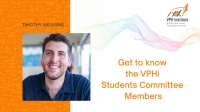With this series of interviews, we want to help VPHi's members get to know one another and involve more and more students in this group, contributing significantly to the Institute's life and the in silico community!

1. Tell us something about yourself!
My name is Tim and I am a first-year PhD student at University College London, England. I completed bachelor’s and master’s degrees in pure mathematics at Cardiff University, Wales, during which I also completely a year-long placement as a statistical programmer at Roche Pharmaceuticals in Welwyn Garden City, England. I then joined UCL, where I obtained an additional master’s in quantum technologies, before commencing on my PhD research in quantum computing for quantum chemistry.
2. How did you first get involved with the VPHi? What is the most significant added value of being a VPHi student member?
Via my PhD supervisor, Prof. Peter Coveney, I have been involved with CompBioMed – a partner of the Virtual Physiological Human Institute. I have now moderated 10+ e-Seminars with CompBioMed, the full list of which are available at www.compbiomed.eu/training with recordings accessible on the YouTube channel www.youtube.com/channel/UCUiIfmesH_psiArXT3xcppA/videos.
3. Can you describe your PhD research work in 3 sentences?
There is a lot of hype surrounding quantum computation, but we are yet to see quantum computers providing solutions to tangible research problems of interest to the wider scientific disciplines. My research aims to advance the state of quantum chemistry using the noisy intermediate-scale quantum (NISQ) devices available today or in the near-term, thus validating the potential of this novel computing paradigm. Of course, there are many challenges to overcome, such as mitigating the inherent noise present in these devices, as well as navigating short coherence times (the window of time before your quantum state dissipates into the environment) and physical qubit-count restrictions.
4. What is the expected outcome you would like to achieve?
Initially, we aim to push the envelope in terms of how large a molecule one can simulate on NISQ hardware, with the ultimate goal being to exceed what is possible classically; we shall benchmark our simulations against best-in-class quantum chemistry techniques such as coupled-cluster and density functional theory.
Longer-term, we hope to see an impact to biomedical research. One wish is to assist in accelerating the drug discovery process, for example by facilitating free-energy calculations based on more accurate descriptions of the small molecule ligands involved in ligand-protein interactions.
5. Have you already published any papers as part of your research work? Or have you reached any results that make you proud?
To facilitate the above, we plan to utilise various projection methods to reduce the dimension of the target electronic structure problem such that it may be accommodated by the available quantum hardware. While this process incurs some systematic error, it may be controlled to still yield molecular energies at relatively high precision. One such technique is Contextual Subspace VQE, developed within our research group and advanced in the following paper:
Weaving, T. J., Ralli, A., Kirby, W. M., Tranter, A., Love, P. J., & Coveney, P. V. (2022). A stabilizer framework for Contextual Subspace VQE and the noncontextual projection ansatz. arXiv preprint arXiv:2204.02150.